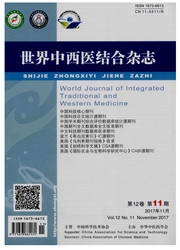

 中文摘要:
中文摘要:
目的检测老年期痴呆(SD)寒凝血瘀证、SD痰浊阻窍证模型大鼠血中一氧化氮(NO)、谷胱甘肽过氧化物酶(GSH-Px)含量,分析其与证候有无相关性。方法采用双侧颈动脉结扎与D-半乳糖腹腔注射相结合建立SD大鼠模型,在疾病模型基础上分别施以投喂高脂饲料和低温环境刺激,建立SD痰浊阻窍证和SD寒凝血瘀证大鼠模型,造模完成后测定血中NO、GSH-Px含量。结果老年期痴呆组、SD寒凝血瘀证、SD痰浊阻窍证三组大鼠血中NO含量显著高于正常组(P〈0.05),但三组间差异无统计学意义(P〉0.05);GSH-Px活性三组均明显低于正常组(P〈0.05),与老年期痴呆组和SD寒凝血瘀证组比较,SD痰浊阻窍证组GSH-Px显著降低(P〈0.05)。结论 GSH-Px与SD痰浊阻窍证可能存在一定的相关性,需扩大样本量并通过临床进一步验证其能否作为反应SD痰浊阻窍证的客观指标之一。
 英文摘要:
英文摘要:
Objective To detect the contents of NO and GSH- Px in blood of the model rats of senile dementia( SD) with syndrome of as stagnation of blood and cold and phlegm blockage to analyze the correlation with the syndromes. Methods The bilateral carotid ligation and intraperitoneal injection of D- galactose were used together to prepare SD rat models. Additionally,the high fat diet and low temperature stimulation were applied to SD models to prepare the models of SD phlegm blockage pattern( SD No. 1) and SD blood and cold stagnation pattern( SD No. 2) separately. After modeling,testing the content of NO and GSH-Px of them. Results NO level was all higher significantly in SD group,SD No. 1 and SD No. 2 group than normal group( P〈0. 05). But the differences were not significant among the three model groups( P 〉0. 05). GSH- Px activity of the three model groups was lower apparently than that in the normal group( P〈 0. 05) and GSH- Px in SD No. 1 was significantly lower than sogroap and SD No. 2. Conclusion GSH- Px may be correlated with SD phlegm blockage pattern. The larger sample size and a further clinical study are required to verify whether it is one of the objective indexes.
 同期刊论文项目
同期刊论文项目
 同项目期刊论文
同项目期刊论文
 期刊信息
期刊信息
